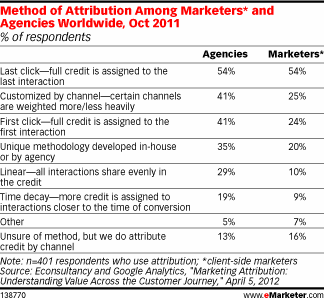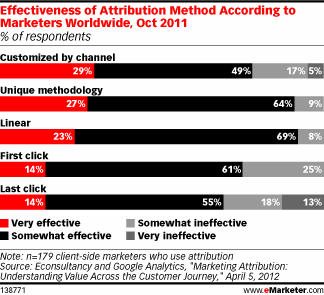
It’s a common tale in digital strategy: marketers get hung up on pieces of data that really don’t say anything about the customer’s online experience, leaving the real, high quality metrics in the dust.
Studies show that the very same story plays out in marketers’ interpretation of the path to purchase. “Marketing Attribution: Understanding Value Across the Customer Journey,” a study by Google Analytics and Econsultancy, looks at how marketers determine which channels deserve credit when customers convert.
Let’s look at an example. A customer performs a search for “sushi in River North,” clicks an organic link on the search engine results page, and peruses the restaurant’s site. She spots a link for the restaurant’s Facebook page, then heads over, reads a few customer comments on the page wall and looks at pictures of the dishes. She gets distracted in Facebook-land, then a few minutes later types the same query as before into Google, recognizes the same restaurant in a paid search ad at the top, quickly clicks and is sent to a landing page where she is prompted to to make reservations. She does, thus completing the conversion.
So . . . which channel should be attributed for that successful conversion? Is it the first? The last? A combination of everything in between?
Unfortunately, most marketers would only credit the very last click on the customer’s path – in this case, the paid search ad. The aforementioned study from Google Analytics and Econsultancy shows that 54% of agencies and marketers rely on last-click attribution.

This credit-where-credit-is-due process deserves closer examination, though. Did the search ad effectively communicate the brand’s message? Well, it must have if the customer filled out the reservation form. But this method ignores any and all interactions with other brand entities (i.e., positive reviews on Facebook, a pleasant and easy-to-navigate layout on the restaurant’s homepage), which very well may have sparked a connection between brand and consumer.
When the stepping stones in the path to purchase are ignored, it makes it harder for community managers, SEOs and other members of the digital marketing team to show that their channels make an impact on the purchasing process.
